Research Article - (2022) Volume 11, Issue 3
The author aims to share his experiences including techniques, outcomes, and complications with the abdominoplasty procedure. 266 patients who underwent abdominoplasty in a Nigeria Clinic between 2017 and 2021 were evaluated in this study. Incisions were made along the marked lines with emphasis on areas with excess skin. The excess skin was cut off carefully, while using a diathermy machine to cauterize any bleeders. The umbilicus was cut out of the excess skin, with the stalk attached to the abdominal wall in order to maintain its blood supply. Postoperative follow up consultations were done for a period of six months to two years. The mean weight of patients for the abdominoplasty procedure was 94.3kg, the mean age of the patients was 42 years and the mean weight of skin excised was 2084g. Based on patients’ satisfaction post-surgery, aesthetically pleasing results were achieved. The techniques and procedures of abdominoplasty have evolved over the years with newer techniques focusing on confining the final scar line chiefly to the "bikini" area.
Tummy Tuck • Africans • Abdominoplasty
Abdominoplasty, also known as tummy tuck, is a procedure that flattens the abdomen by removing extra fat and skin from the anterior abdominal wall. It also involves tightening weakened rectus muscles in abdominal wall (rectus plication) and resuturing of the elevated skin flap back to the lower abdomen. Patients that request an abdominoplasty usually have three types of abdominal wall – flaccid, round, or pendulous among which are several sub-types causing various aesthetic issues (Figure 1)Candidates considered appropriate for an abdominoplasty include: (i) women who have stretched skin and muscles due to pregnancies, (ii) isolated abdominal hernia, (iii) present or past obese individuals who lost weight or who had bariatric surgery done, (iv) individuals with skin that is too thin due to poor elastic fibres, (v) patients who have vertical scars in the infra-umbilical region from previous caesarean and other gynaecological operations or even general surgery procedures, (vi) men and women who are in good general health and are at a stable weight (exceptions to this stable weight rule include patients with comorbidities or those with a large panniculus in the lower abdomen). Abdominoplasty can be done as a solo procedure or in combination with other aesthetic procedures like breast lift, breast augmentation, gluteal augmentation and the likes.
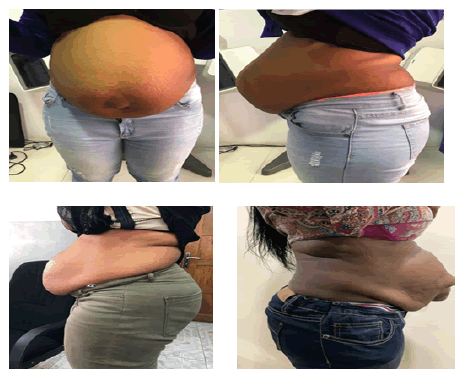
Figure 1: Pictures of commonly presented tummy tuck patients showing the various shapes of abdominal wall.
In this study, we share our experiences on abdominoplasty, abdominal contouring techniques, outcomes and common complications amongst 266 Africans who underwent the procedure in our private clinic in Nigeria. This report is important because there is a
The term ‘Abdominal lipectomy’ was first used by Kelly, a gynaecological surgeon from the United States at John Hopkins Hospital in Baltimore in 1899 to describe surgical removal of abdominal fat [1]. He performed herniorrhaphy through a transverse incision extending across the abdominal flanks (Figure 2). This technique resulted in sacrificing the umbilicus while the abdominal pannus was successfully resected, and the incision properly closed [2].
Figure 2: Kelly Transverse Incision.
Weinhold, a German surgeon in 1909, reported the cloverleaf incision which is a combination of vertical and oblique incisions to improve the contour of the abdominal wall (Figure 3) [3]
Figure 3: Weinhold cloverleaf incision.
Babcock in 1916, described a vertical elliptical incision down the length of the abdomen, which was modified by Schepelmann in 1918, into a transverse teardrop incision extending from the xyphoid to the pubis that allowed for more contouring of the lower abdominal excess (Figures 4 and 5) [4,5].
Figure 4: Babcock vertical elliptical incision.
Figure 5: Schepelmann transverse tear drop incision.
The technique of placing the incision below the umbilicus in a transverse fashion was started by Thorek in 1924 [6]. He removed the excess skin and fat down to the fascia in a wedge-shaped form which he termed plastic adipectomy (Figure 6).
Figure 6: Thorek plastic adipectomy.
Later in 1949 and 1950 respectively, Pick and Barsky modified the Thorek transverse incision with the addition of the vertical incision at the end (Figure 7).
Figure 7: Pick and Barsky transverse incision.
The technique of resection of the abdomen into four quadrants was then reported by Galtier in 1955 (Figure 8) [7].
Figure 8: Galtierâ??s technique of abdominal resection into four quadrants.
The technique of resection of the abdomen into four quadrants was Dufourmental and Mouly in 1959 modified the 1957 Vernon technique of low transverse incision with wide undermining and transposition of the umbilicus and the addition of a small vertical incision at the centre (Figure 9,10) [8,9].
Figure 9: Vernonâ??s low transverse incision with wide undermining and transposition of the umbilicus.
Figure 10: Dufourmental and Mouly Modified Vernon technique with the addition of a small vertical incision at the centre.
Pitanguy in 1967, popularized the technique of low transverse incision with wide undermining of the umbilicus, plication of the rectus sheath and relocation of the umbilicus. Regnault in 1972, published the W technique for abdominoplasty (Figure 11) [10,11].
Figure 11: Pitanguy's low transverse incision with wide undermining of the umbilicus.
Recently, most plastic surgeons have utilized the horizontal incisions with various newer techniques which include suction-assisted lipectomy, high lateral tension closure with fascial suspension, and external oblique fascial advancement to create a smaller waistline.
The techniques of the surgical procedure should align with the following objectives which are important in abdominoplasty (i) placement of the incisions within the bikini line, (ii) flattening and tightening the abdomen, (iii) reduction of the size of the waistline, (iv) reduction of the thickness of the subcutaneous fat throughout the abdomen, flanks, and iliac areas, (v) rejuvenation of the pubis from a triangular senescence to an oval youthful form, (vi) lifting of the lax anterolateral thigh skin near the groin crease and iliac areas, (vii) creation of a well-defined xiphoumbilical depression, (viii) changing body posture, (ix) correction of any hernia.
Preoperative planning
tient and should include asking about the numbers of children and if the patient is done with childbearing. These questions are necessary because the procedure is best done after a female patient is done with childbearing, as pregnancy could undo the work done by an abdominoplasty procedure. Though we have not taken the average number of children into cognizant, many usually have 2-3 children. This does not mean that is the average for the population but it is the average for the people who can afford the procedure. Other general inquiries about contraceptive use, history of deep vein thrombosis, previous abdominal surgery, previous liposuction, current medications, herbal foods or supplements (blood thinners), co-morbidities like history of hypertension or diabetes are also important [12,13].
The risks of the procedure should be clearly explained to the patient with emphasis on deep vein thrombosis, bleeding, seroma formation, wound dehiscence, skin necrosis and liposuction burn. It is important to note that some unsatisfied clients return due to some of the risks mentioned above.
The age of the patient is very important in management as we have a variety of patients from 20s to 60s. Prognosis following the surgical procedure gets better with the decreasing age of patients. Obesity is also a very vital part of this procedure as obese patients tend to have more complications compared to patients with a BMI within the normal range
Although there have been various publications on the use of local or regional anesthesia in abdominoplasty, general anesthesi is usually the ideal method in our practice.
Examination of the patient should be done with the patient standing and lying supine as this gives a clear assessment of the abdomen. This may also help to identify the patients that could have some degree of respiratory compromise after abdominal recti plication. In these patients, we advise respiratory exercise weeks before the planned procedure date. In order to ensure that there is no respiratory compromise after surgery, other parameters are evaluated during plication of the rectus muscle. They include measuring the plication distance, the intratracheal pressure of the patients and infiltration of the rectus muscle with plain mercaine to reduce postop pain. In addition, the incentive spirometer is utilized to ensure full capacity of the lungs after surgery.
With the patient in the anatomical position, preoperative markings are done with emphasis on areas with excess skin. A line is drawn from the anterior superior iliac spine (ASIS) on one side to the other side (classic type). Taking a closer look at the excess skin fold as it ends on the groin area while the patient flexes the abdomen by bending forward is a good way of ensuring that most of the excess skin is taken out. This is known as the pinch test or roll (Figure 12).
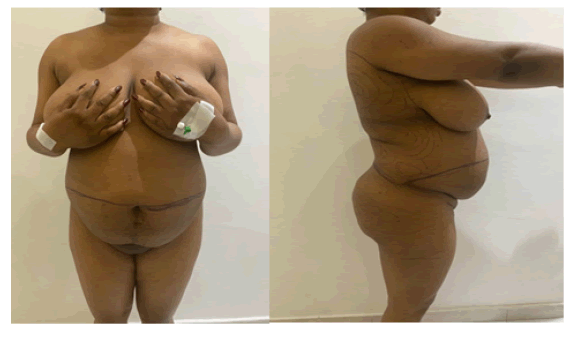
Figure 12: Patient marking in upright position
Patients are placed in the supine position while general anaesthesia is administered. The marked areas of the abdomen are infiltrated with tumescent fluid containing adrenaline, lidocaine and normal saline mixed in a 50mL syringe. In our clinic, liposuction of the back is as a component of the abdominoplasty surgery to achieve a better body contour. Liposuction of the anterior abdomen is not done with abdominoplasty because of the risk of skin necrosis leading to poor healing of the surgical areas. If the patient requesting an abdominoplasty has a large fat abdominal thickness, they are advised to do a circumferential liposuction months before the The surgery starts with an incision along the marked lines. The excess skin is cut off carefully, while using a diathermy machine to cauterize any bleeders. The umbilicus is cut out of the excess skin, with the stalk attached to the abdominal wall in order to maintain its blood supply (Figure 13).
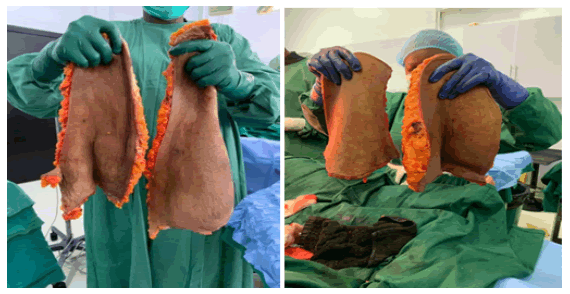
Figure 13: Excised skin.
The dissection of the abdominal wall from the rectus sheath is extended from the umbilicus to the xiphisternum while the skin is elevated.
The plication distance is marked and measured, and plication is done using PDS 2 stitches. Double plication is done running from the umbilicus to the xiphisternum and back. The intratracheal pressure is monitored throughout the plication to ensure that respiratory compromise postsurgery is avoided. Infiltration of the rectus muscle and the xiphisternal area is done with heavy mercaine constitute.
Suturing of the lower skin flap is done using quilting stitches to reduce the dead space created during the procedure. A drain may or may not be inserted based on the physician’s assessment of the patient. Suturing of the lower skin is done using vicryl 2 and vicryl 0 stitches. A new incision is finally made for the umbilicus along the midline and the umbilicus is sutured to its new position (Figure 14)
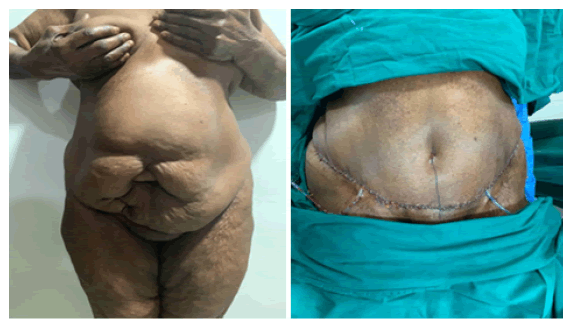
Figure 14: Patient's before and after picture.
Post-operative Care
Patients are discharged at least 3 days postoperatively, with early mobilisation and resumption of sedentary activities at 2 weeks postoperatively and normal activities at 4 weeks postoperatively. Multiple follow-up consultations are also done within a period of 6 months to 2 years. During the recovery period, early mobilization is encouraged, and post op care involves routine antibiotics, anti-inflammatories, and haematinics
and May 2021 were evaluated in this study. Approval from an institutional review board or ethics committee was not obtained because all patients underwent surgical procedures in a private practice in Nigeria. However, the study was conducted in accordance with the Declaration of Helsinki principles. All patients were supplied with detailed information regarding the surgical procedure, and all patients provided written informed consent.
Patients who were active smokers and chronic alcoholics were not considered for this procedure. The medical charts of all patients were reviewed, and pre- and post- operative photographs were obtained.
From this study, the mean weight of patients for the abdominoplasty procedure was 94.3 kg (ranging from 55.4-148.5kg), the mean age of the patients was 42 years (ranging from 24-67 years) and the mean weight of skin excised was 2084g (ranging from 300-11,600g).
The average volume of fluid used for infiltration of the skin was 2568.5ml (ranging from 180-9,000ml) and the average blood lost during the procedure was 314.1ml (ranging from 20-1,200ml). The surgeries were performed for a duration of one hour to five hours. Of the 266 patients who had abdominoplasty done, 166 patients were female and only 1 patient was a male
Figure 15 describes the trend observed in the ages of the patients for this procedure: 0.7% of the patients were below 20 years, 10% were between ages 20-30 years, 48% were between ages 31-40 years, 33% were between ages 41-50 years, 5% of the patients were between ages 51-60 and 3% were between the ages of 61%-70% (Figure 15)
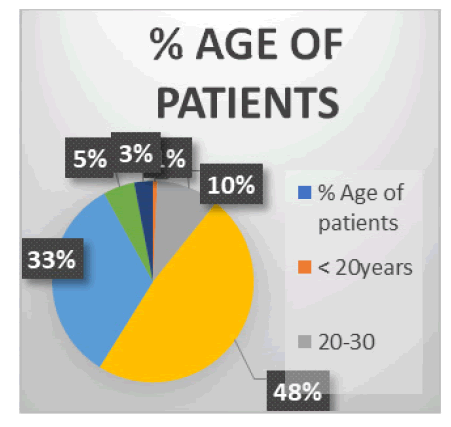
Figure 15: Describes the % age of patients for Abdominoplasty.
This report showed that the patients with the most interest in the abdominoplasty procedures were between the ages of 31 and 50 years with most patients between the ages of 31 to 40 years.
11.5% of the patients weighed between 55-75kg, 50% of the patients weighed between 75-95kg, 27.4% of the patients weighed between 95- 115kg, 7.6% of the patients weighed between 115-135kg and 3.8% of the patients weighed between 135-155kg as described from the bar chart (Figure 16)
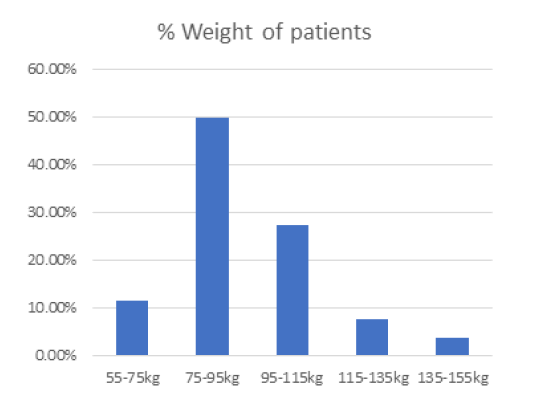
Figure 16: Describes the weight of patients for Abdominoplasty.
From the bar chart, 69% of the patients had ≤3000g of skin excised, 26% had between 3000-6000g of skin excised from their abdomen and 5% of the patients had between 6000-12000g of skin excised from their abdomen. The highest percentage of patients had excised skin weight of ≤3000g from the abdomen (Figure 17).
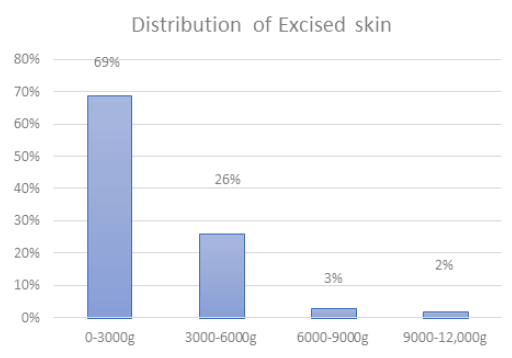
Figure 17: Describes the excised skin weight of patients for Abdominoplasty.
Complications
The decision to carry out abdominoplasty procedure is extremely personal, and it should be decided if the benefits will achieve the goals stated earlier. Male patients have been reported by Van Uchelen et al., [13] to have a higher risk of complications, and special attention should be given by the surgeon to prevent such complications
The common complications of abdominoplasty include risks associated with anesthesia, bleeding, asymmetry, deep vein thrombosis and pulmonary embolism, cardiac and pulmonary complications, fat necrosis, risk of infections, seroma, poor wound healing, persistent pain, possibility of revisional surgery, skin loss, suboptimal aesthetic result, unfavourable scarring among others.
Abdominoplasty procedures and techniques have evolved over the years with newer techniques focusing on confining the final scar line chiefly to the "bikini" area. Although abdominoplasty and other cosmetic procedures were once regarded as a taboo in Africa, they are steadily gaining a lot of popularity among its women and men.
Abdominoplasty, although having its complications like every other procedure, has been shown to give desired aesthetics results as the patients that had this procedure were pleased with their results.
[Google Scholar] [Cross Ref]
[Google Scholar] [Cross Ref]
[Google Scholar] [Cross Ref]
Citation: Aranmolate A. R. et. al. Abdominoplasty: My Experience in The Last 5 Years in Nigeria - Abdominoplasty in Africans. Reconstr Surg Anaplastol, 2022, 11(3), 10-14
Received: 28-Jun-2022, Manuscript No. ACR-22-18657; Editor assigned: 30-Jun-2022, Pre QC No. ACR-22-18657 (PQ); Reviewed: 07-Jul-2022, QC No. ACR-22-18657 (Q); Revised: 11-Jul-2022, Manuscript No. ACR-22-18657 (R); Published: 18-Jul-2022, DOI: doi.10.37532/22.11.3.10-14
Copyright: © 2022 Aranmolate A. R. et al. This is an open-access article distributed under the terms of the Creative Commons Attribution License, which permits unrestricted use, distribution, and reproduction in any medium, provided the original author and source are credited.